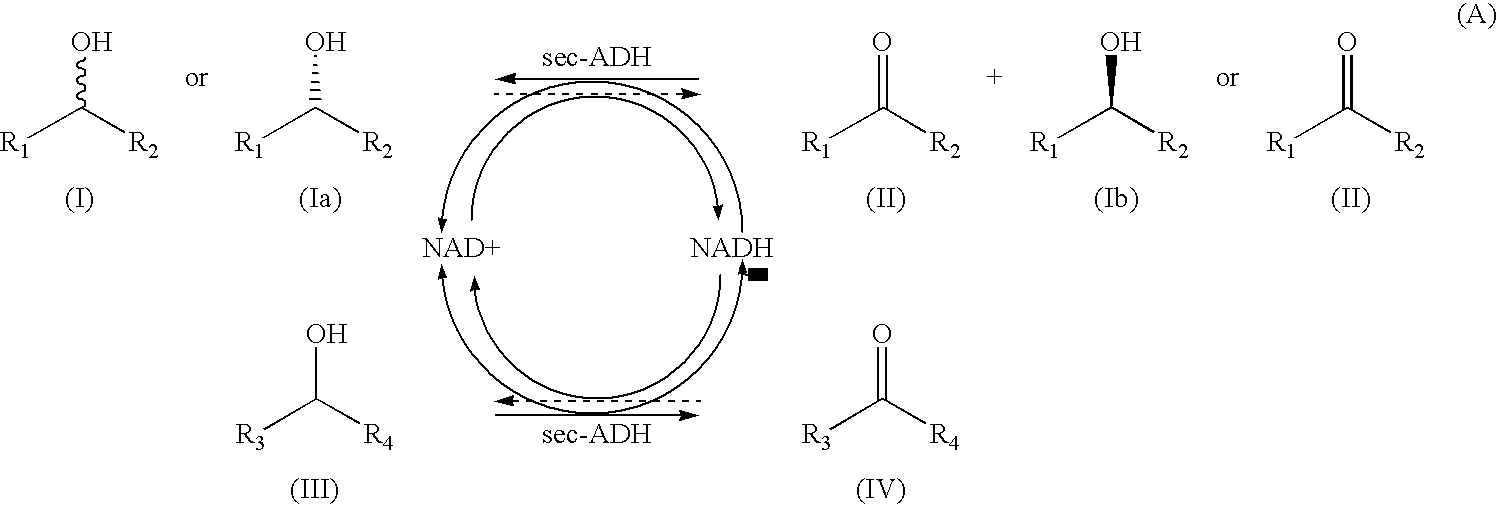Alcohol dehydrogenases with increased solvent and temperature stability
- Summary
- Abstract
- Description
- Claims
- Application Information
AI Technical Summary
Benefits of technology
Problems solved by technology
Method used
Image
Examples
example 1
Cultivation of Rhodococcus ruber DSM 14855
[0139] The Gram-positive bacterium Rhodococcus ruber DSM 14855 is grown under aerobic conditions in baffled Erlenmeyer flasks at 30.degree. C. and 130 rpm using a complex medium containing yeast extract, peptone, glucose and mineral salts (10 g / l yeast extract (OXOID CM129, OXOID Ltd., Hampshire, England), 10 g / l peptone, 2 g / l NaCl, 0.15 g91 MgSO.sub.4.7H.sub.2O, 1.3 g / l NaH.sub.2PO.sub.4, 4.4 g / l K.sub.2HPO.sub.4) for three days. Cell growth is followed by determination of the optical density via absorption at 546 nm, see Table 1. After a centrifugation (2000 g, 20 min), the pellet is taken up in Tris-HCl buffer pH 7.5 (50 mM), shock-frozen in liquid nitrogen and lyophilised.
[0140] The cells produce several NAD+ / NADH-dependent sec-alcohol dehydrogenases without any induction. The highest sec-alcohol dehydrogenase activity is displayed during the late exponential and early stationary phase of the growth curve (see table 1). The activity is ...
example 2
Purification of a sec-Alcohol dehydrogenase `ADH-A` from Rhodococcus ruber DSM 14855
[0142] a) Cell Disruption
[0143] Bearing in mind that the sec-alcohol dehydrogenase might be a membrane-associated or even membrane-bound protein, cell disruption using a Vibrogen cell mill (glass beads, diameter 0.25 mm, Vibrogen Zellmuhle, E. Buhler, Typ VI-4; Braun Biotech Int., Melsungen, Germany) is used and optimised in order to obtain the majority of the activity in the cell-free lysate and not in the cell debris fraction. This results in an exceptionally long and rough procedure of 7 shaking cycles of 2 min agitation / 5 min cooling each. The enzyme shows high stability against this strong mechanical treatment. The buffer used for cell disruption is 10 mM Tris-HCl buffer, pH 7.5.
4TABLE 2 Optimization of the cell disruption by increasing number of shaking cycles Relative 48 60 71 85 82 97 100 93 82 Activity [%] Number 1 2 3 4 5 6 7 8 9 of shaking cycles
[0144] b) Pre-Treatment with DEAE-Cellulose:...
example 3
Purification Control and Molecular Weight Determination by Gel Electrophoresis
[0180] The progress of the protein purification is controlled by native as well as by SDS-polyacrylamide gel electrophoresis (PAGE). For both methods, the protein fractions are subjected to a Laemmli SDS-PAGE system using a MINI-PROTEAN II dual slab cell (BioRad).
[0181] a) Native Gel Electrophoresis
[0182] Active fractions are treated with non-denaturing sample buffer and loaded on a polyacrylamide gel (12%) without SDS. The gel is run at 4.degree. C. at 150 V with running buffer containing 15 g / l Tris and 72 g / l Glycine. The method for visualization of sec-alcohol dehydrogenases in polyacrylamide gels was first reported by Grell et al. [see Science 149, 80 (1965)] and is based on a staining solution [see Dodgson et al., Biochem. J. 187, 703 (1996)] mixed from aqueous 4 mM 2-octanol (or any aliphatic, long-chained sec-alcohol accepted as substrate) and 100 mM Tris-HCl buffer pH 8.5 containing 3 g / l NAD.sup....
PUM
| Property | Measurement | Unit |
|---|---|---|
| Fraction | aaaaa | aaaaa |
| Time | aaaaa | aaaaa |
| Angle | aaaaa | aaaaa |
Abstract
Description
Claims
Application Information
 Login to View More
Login to View More - R&D
- Intellectual Property
- Life Sciences
- Materials
- Tech Scout
- Unparalleled Data Quality
- Higher Quality Content
- 60% Fewer Hallucinations
Browse by: Latest US Patents, China's latest patents, Technical Efficacy Thesaurus, Application Domain, Technology Topic, Popular Technical Reports.
© 2025 PatSnap. All rights reserved.Legal|Privacy policy|Modern Slavery Act Transparency Statement|Sitemap|About US| Contact US: help@patsnap.com



